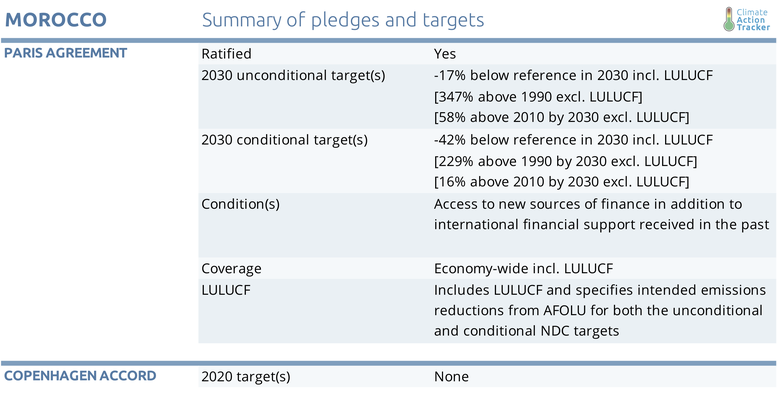Pledges And Targets
Summary table

Paris Agreement
In September 2016, Morocco ratified the Paris Agreement, and submitted its NDC to the UNFCCC (Government of Morocco 2016c). It aims to unconditionally reduce GHG emissions including land use, land use change and forestry (LULUCF) in 2030 by 17% below business as usual (BAU) projections, resulting in emissions of 142 MtCO2e/year in 2030. Conditional upon access to new sources of finance, and on additional support compared to that received in the past, Morocco would increase its GHG emissions reductions including LULUCF to 42% below BAU in 2030, resulting in emissions of 99 MtCO2e/year in 2030. The absolute GHG emission level excluding LULUCF emissions resulting from the unconditional NDC emission reduction target in 2030 is 145 MtCO2e. The conditional target would lead to additional reductions and a lower emissions level of 107 MtCO2e in 2030 excluding LULUCF.
In comparison to Morocco’s INDC submitted on 5 June 2015 (Government of Morocco 2015), the NDC it submitted a year later raises ambition in intended emissions reductions—both under the unconditional and conditional target—by explicitly including additional emissions reduction contributions from agriculture, forestry and other land use (AFOLU). The NDC further specifies which measures will be undertaken to achieve its unconditional (24 measures) and conditional (an additional 31 measures) NDC targets and thus increases transparency on Morocco’s emissions reduction efforts.
In its NDC submission, Morocco included projections for the BAU emissions trajectory from 2010 to 2030 that have been revised downwards in both the 1st Biennial Update Report and the 3rd National Communication, submitted in April 2016 (Government of Morocco 2016d, 2016a).
The NDC reports unconditional and conditional target emissions levels, both including and excluding intended emissions reductions from agriculture, forestry and other land use (AFOLU). In both conditional and unconditional emissions pathways, emissions in 2020 are lower than in 2018 and then either stabilise or increase again. Part of the emissions ‘dip’ in 2020 in the unconditional pathway comes from the fact that two actions responsible for 36% of the reductions, the National Wind Plan for 2020 and the National Solar Plan for 2020, are projected to achieve their targets in 2020.
The 1st Biennial Update Report and the 3rd National Communication (Government of Morocco 2016d, 2016a) further outline these identified mitigation actions, providing detailed descriptions and respective emissions reduction estimates. To implement these actions, Morocco requires an overall investment of USD $50 billion between 2010 and 2030. Of this, USD $24 billion are expected to come from access to new sources and to additional support, compared to that received over the past years (Government of Morocco 2016c).
Further analysis
Latest publications
Stay informed
Subscribe to our newsletter




